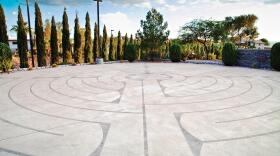A couple of familiar faces are betting on a project they think will push the Arts District to new cultural heights
In the late 1980s, a group of high-profile business and community leaders brought New York artist Jenny Holzer to town to scroll her famous “truisms” — example: “Protect me from what I want” — on the Caesars Palace electronic marquee. It was a milestone event for Las Vegas made possible by the Nevada Institute for Contemporary Art and its well-connected founders Roger Thomas and Steven Molasky. NICA went on to mount exhibits and host impressive fundraisers before disbanding in the 1990s.
What makes this relevant today is Molasky’s attempt to create another artistic milestone. He has purchased eight parcels on Commerce Street, between Charleston Boulevard and Gass Avenue, mostly industrial buildings along the railroad, and intends to revamp them into a mixed-use complex of art galleries and venue spaces that would accommodate large-scale works, exhibits, installations, and events in rotating spaces — and, possibly, artists’ studios and residential spaces.
All of it will be tied to Smart Initiative, a new cultural organization headed by arts consultant Michele Quinn, which will serve as a project-based institution focused on contemporary art. They’ve been working on it quietly for nearly two years, and as Quinn says, it’s a “lean-running institution,” comprising her, Molasky, and her staff.
One small portion of the project has already been unveiled. The two worked to secure the Commerce Street space that recently hosted the popular two-month run of Tilting the Basin, a large exhibit surveying Nevada’s contemporary arts scene, which Quinn cocurated with the Nevada Museum of Art’s Joanne Northrup. The 14,000-square-foot space, at 920 S. Commerce, already revamped into a whistle-clean functional venue, will be kept active for future arts projects. The others along Commerce Street will undergo renovations over the next couple of years. Not all will be used consistently or simultaneously (and some Smart Initiative projects will take place elsewhere around the valley).
All of this began after a conversation the two had a couple of years ago about NICA and its role in the arts. The Las Vegas natives met regularly to find a project that would add value to the city’s arts and cultural experience. The Smart Initiative, Quinn says, is a multivenue institution that will be flexible and open to different possibilities — exhibits, events, indoor-outdoor installations. One large installation project by a well-known international artist is already being developed and will be announced once it’s farther along.
If seen through to fruition, Molasky’s Commerce Street project could have an outsized impact on the Arts District, which has seen a more thriving gallery scene in years past (Dust Gallery, GC Arts, Contemporary Arts Center, Trifecta Gallery, Blackbird Studios), but which is now better known for boutiques, antique stores, bars, and coffee shops than for art. “What we’re really trying to accomplish is to bring new life to the area and a new perspective as to what Las Vegas can be as a cultural destination, locally as well as nationally,” Quinn says.
And it’s coming to light at what seems like a fertile time for Downtown art. West from Molasky’s properties, across the railroad tracks, where serious public and private dollars have already been invested in the arts with The Smith Center for the Performing Arts, there’s now the growing possibility of a new facility, the Art Museum at Symphony Park, a nonprofit effort quietly raising funds for a contemporary art museum. In May, the Senate Finance Committee heard Senate Bill 187, which would allocate $10 million in matching state funds for the construction of the building, and also allow for expansion of the Nevada Museum of Art, which has been discussing a potential merger with the Las Vegas museum. The Las Vegas facility was originally envisioned for the Arts District, but its new board (which includes Quinn) opted for Symphony Park.
Molasky refers to Commerce Street — now under construction as part of the city of Las Vegas’ $36 million project to turn the parallel Main and Commerce streets into one-way roads — as the Historic Railroad Neighborhood. Some of the buildings on the west side of the street open up directly to loading docks facing the railroad tracks that helped establish Las Vegas. Molasky says that in addition to reactivating the industrial buildings for exhibits and events, some buildings will include live/workspaces tied to the arts. Other property owners on the street are also working on projects, he says.
“It’s really a play of passion to me,” he says. “The art being produced here and going through here is really significant. I’ve always been a painter, collector, and lover of art. I really believe in the vibrancy of our local artists and community.”
The Molasky family imprint in Las Vegas is huge. Steven Molasky is son of real-estate developer Irwin Molasky, who arrived in the 1950s, built Paradise Palms as the city’s first master-planned community, Sunrise Hospital, Boulevard Mall, high-rise condos, Downtown offices, and the IRS headquarters in Las Vegas. Known also for his philanthropy, he was the one who donated 45 acres of land on Maryland Parkway for what is now UNLV.
Steven Molasky has always been dedicated to the arts, says Pamela Puppel, spokeswoman for the Molasky Group of Companies, a comment echoed by others, including Quinn, a Las Vegas-based art advisor who was involved in putting together CityCenter’s $40 million art collection. Behind Puppel, architect Rob Gurdison rolls open one of the warehouse doors at 924 Commerce, which previously had Catholic Charities as a tenant. Sunlight blasts in, allowing for a better view of the old barrel-vaulted ceiling. Gurdison says one of the reasons this area was selected was because of its history, its location in a public realm (rather than a master-planned community), and because it sits within the Arts District.
“Instead of getting land and scraping off old buildings, which sometimes has to happen, and then gentrify it for business, we’d rather have control of what the environment’s going to be, utilizing the body and energy that’s there,” Gurdison says.
“We’ve identified about 12 acres. Everything between Gass and Charleston on either side of Commerce is the initiative. Most of the buildings we’ve invested in we found to be reusable. Some parcels will include urban infill and some adaptive reuse.”
As to whether anything might hold up or derail his project, Molasky said he didn’t think so, though, having declared bankruptcy during the recession, he might be aware of the ups and downs of big plans in Las Vegas. And the Arts District has seen its share of failed big plans, from museum proposals to a sculpture garden with no sculpture next to the Arts Factory
Still, for Molasky, who says this creates the opportunity for “larger, edgier programming” in a suitable industrial area, it’s all about the art: “It’s really an exciting project for me and for us.”
Corrections: The original version of this story misidentified Pamela Puppel, and indicated that Senate Bill 187 applied to the Nevada State Museum rather than the Nevada Museum of Art.








